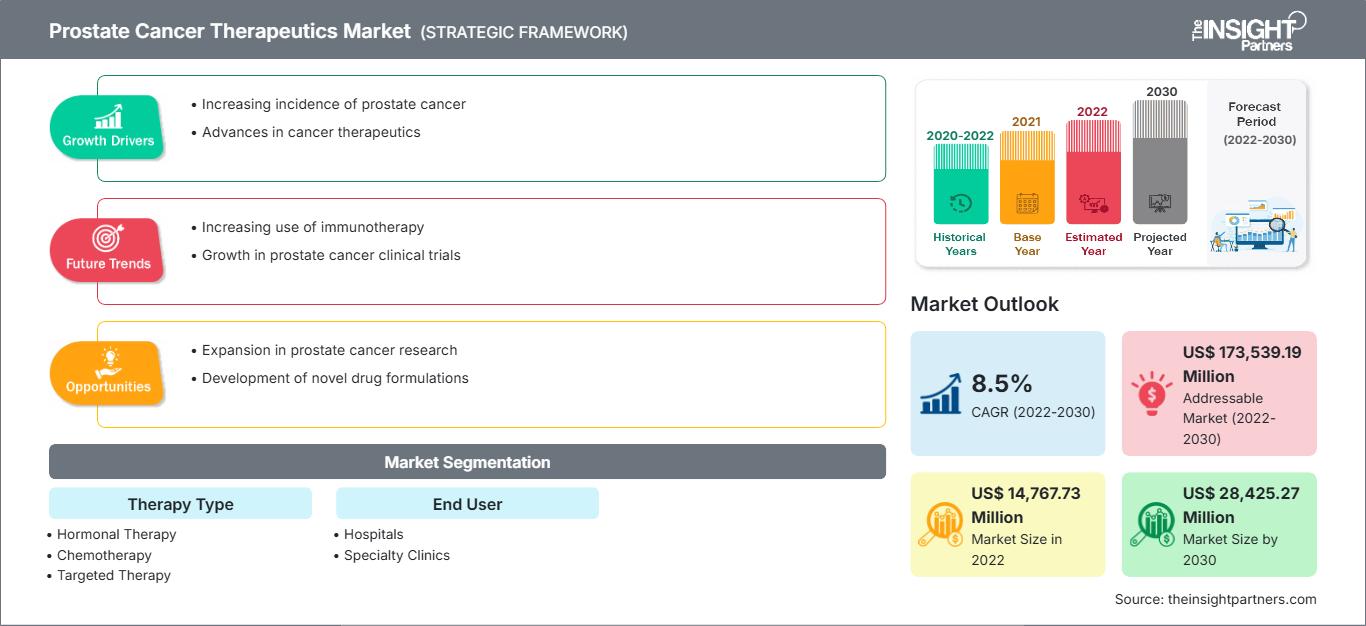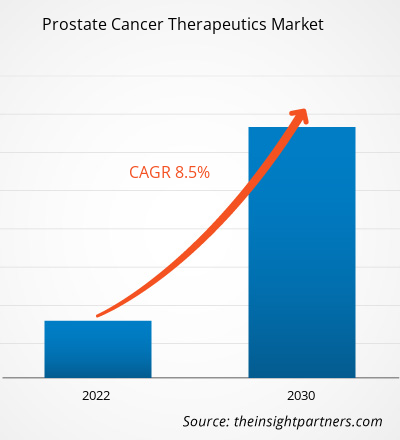[Informe de investigación] Se prevé que el mercado de tratamientos para el cáncer de próstata crezca de 14.767,73 millones de dólares estadounidenses en 2022 a 28.425,27 millones de dólares estadounidenses en 2030; se anticipa que registre una tasa de crecimiento anual compuesta (TCAC) del 8,5% entre 2022 y 2030.
Perspectivas del mercado y opinión de los analistas:
El mercado de tratamientos para el cáncer de próstata está en expansión debido al aumento de las actividades de I+D para introducir nuevos fármacos, el creciente número de casos de cáncer de próstata y el mayor apoyo gubernamental para su diagnóstico. Además, la disponibilidad de productos avanzados por parte de las empresas del sector impulsa el crecimiento del mercado. En enero de 2023, BDR Pharmaceutical lanzó en India una versión genérica de apalutamida, utilizada para tratar el cáncer de próstata. El fármaco se comercializa bajo la marca APATIDE y se prescribe para tratar el cáncer de próstata resistente a la castración no metastásico y el cáncer de próstata sensible a la castración metastásico.
Factores de crecimiento y desafíos:
El cáncer de próstata es uno de los problemas de salud más comunes en los hombres, especialmente en los mayores de 50 años. Es más frecuente en hombres obesos con antecedentes familiares de cáncer de próstata. Se trata de una amenaza silenciosa, ya que a menudo se desarrolla sin síntomas evidentes. Por lo tanto, su detección temprana no es sencilla. La mayoría de los cánceres de próstata se originan en la periferia de la glándula. Para que aparezcan los síntomas, el cáncer debe alcanzar un tamaño que ejerza presión sobre la uretra; en algunos casos, el dolor óseo debido a la metástasis puede ser el primer síntoma de un cáncer de próstata avanzado. Sin embargo, cualquier persona mayor de 50 años que presente síntomas del tracto urinario inferior, disfunción eréctil o hematuria debe considerar la posibilidad de padecer cáncer de próstata. Este cáncer es la quinta causa principal de muerte por cáncer en hombres a nivel mundial y el segundo cáncer más diagnosticado. Aunque la incidencia del cáncer de próstata ha disminuido desde el año 2000, se observa un aumento en la incidencia de cáncer de próstata en etapas avanzadas desde 2010. Las tasas de incidencia y mortalidad por cáncer de próstata difieren considerablemente. En general, los países desarrollados presentan una mayor incidencia de cáncer de próstata, pero una menor mortalidad. El riesgo de padecer cáncer de próstata en Estados Unidos es casi cuatro veces mayor que el riesgo global. Según Novartis AG, en 2020 se notificaron aproximadamente 1,4 millones de nuevos casos de cáncer de próstata y cerca de 375 000 muertes por esta enfermedad en todo el mundo. El creciente número de casos de cáncer de próstata a nivel mundial y la baja tasa de detección impulsan el crecimiento del mercado de tratamientos para esta enfermedad.
Obtendrá personalización gratuita de cualquier informe, incluyendo partes de este informe, análisis a nivel de país y paquetes de datos de Excel. Además, podrá aprovechar excelentes ofertas y descuentos para empresas emergentes y universidades.
Mercado de terapias para el cáncer de próstata: Perspectivas estratégicas

- Obtenga las principales tendencias clave del mercado que se describen en este informe.Esta muestra GRATUITA incluirá análisis de datos, que abarcarán desde tendencias de mercado hasta estimaciones y pronósticos.
Segmentación y alcance del informe:
El mercado de tratamientos para el cáncer de próstata se segmenta según el tipo de terapia, el usuario final y la geografía. Por tipo de terapia, se divide en terapia hormonal, quimioterapia, inmunoterapia, terapia dirigida y otras. Por usuario final, se segmenta en hospitales, clínicas especializadas y otros. Geográficamente, se divide en Norteamérica (Estados Unidos, Canadá y México), Europa (Reino Unido, Alemania, Francia, Italia, España y el resto de Europa), Asia Pacífico (China, Japón, India, Corea del Sur, Australia y el resto de Asia Pacífico), Oriente Medio y África (Emiratos Árabes Unidos, Arabia Saudita, Sudáfrica y el resto de Oriente Medio y África) y Sudamérica y Centroamérica (Brasil, Argentina y el resto de Sudamérica y Centroamérica).
Análisis segmentario:
El mercado de tratamientos para el cáncer de próstata, según el tipo de terapia, se segmenta en terapia hormonal, quimioterapia, inmunoterapia, terapia dirigida y otros. En 2022, la terapia hormonal representó la mayor cuota de mercado después de la quimioterapia, y se prevé que registre la mayor tasa de crecimiento anual compuesto (TCAC) entre 2022 y 2030. La quimioterapia se considera un tratamiento importante para el cáncer de próstata. En esta terapia, los fármacos destruyen las células cancerosas, tanto nuevas como existentes, en los pulmones. La quimioterapia para el cáncer de próstata metastásico puede aliviar los síntomas, reducir la carga tumoral y mejorar la calidad de vida. El docetaxel (Taxotere) se considera el tratamiento estándar en la quimioterapia para el cáncer de próstata en pacientes resistentes a la terapia hormonal. La FDA también ha aprobado el fármaco quimioterapéutico cabazitaxel (Jevtana) para el tratamiento del cáncer de próstata resistente a la castración. También se utiliza en pacientes con cáncer de próstata metastásico que ha progresado durante el tratamiento con docetaxel.
Análisis regional:
El mercado de tratamientos para el cáncer de próstata se segmenta geográficamente en Norteamérica, Europa, Asia Pacífico, Oriente Medio y África, y Sudamérica y Centroamérica. Norteamérica es el principal contribuyente al crecimiento del mercado mundial de tratamientos para el cáncer de próstata. Se prevé que Asia Pacífico registre la mayor tasa de crecimiento anual compuesto (TCAC) en este mercado entre 2022 y 2030. El crecimiento del mercado de tratamientos para el cáncer de próstata en Estados Unidos se debe principalmente al aumento de la incidencia de este cáncer, los lanzamientos de productos y las iniciativas gubernamentales. En junio de 2023, Lynparza (olaparib), de AstraZeneca y MSD, en combinación con prednisona o prednisolona y abiraterona, fue aprobado en Estados Unidos para el tratamiento de pacientes adultos con sospecha de cáncer de próstata metastásico resistente a la castración (CPRCm) con mutación BRCA deletérea (BRCAm). Además, en noviembre de 2023, la FDA aprobó enzalutamida, un producto fabricado por Astellas Pharma US, Inc. El producto se utiliza para el tratamiento del cáncer de próstata sensible a la castración no metastásico (nmCSPC) con recurrencia bioquímica con alto riesgo de metástasis (BCR de alto riesgo).
Perspectivas regionales del mercado de tratamientos para el cáncer de próstata
Los analistas de The Insight Partners han explicado en detalle las tendencias y los factores regionales que influyen en el mercado de tratamientos para el cáncer de próstata durante el período de previsión. Esta sección también analiza los segmentos y la distribución geográfica del mercado de tratamientos para el cáncer de próstata en Norteamérica, Europa, Asia Pacífico, Oriente Medio y África, y Sudamérica y Centroamérica.
Alcance del informe de mercado de terapias contra el cáncer de próstata
| Atributo del informe | Detalles |
|---|---|
| Tamaño del mercado en 2022 | US$ 14.767,73 millones |
| Tamaño del mercado para 2030 | US$ 28.425,27 millones |
| Tasa de crecimiento anual compuesto global (2022 - 2030) | 8,5% |
| Datos históricos | 2020-2022 |
| período de previsión | 2022-2030 |
| Segmentos cubiertos | Por tipo de terapia
|
| Regiones y países cubiertos | América del norte
|
| Líderes del mercado y perfiles de empresas clave |
|
Densidad de los participantes en el mercado de terapias contra el cáncer de próstata: comprensión de su impacto en la dinámica empresarial
El mercado de tratamientos para el cáncer de próstata está creciendo rápidamente, impulsado por la creciente demanda de los usuarios finales debido a factores como la evolución de las preferencias de los consumidores, los avances tecnológicos y una mayor conciencia de los beneficios del producto. A medida que aumenta la demanda, las empresas amplían su oferta, innovan para satisfacer las necesidades de los consumidores y aprovechan las nuevas tendencias, lo que impulsa aún más el crecimiento del mercado.

- Obtenga una visión general de los principales actores del mercado de terapias para el cáncer de próstata.
Desarrollos de la industria y oportunidades futuras:
A continuación se enumeran diversas iniciativas de actores clave que operan en el mercado de terapias contra el cáncer de próstata:
- En marzo de 2022, la FDA de EE. UU. aprobó Pluvicto (lutetium Lu 177 vipivotide tetraxetan) de Novartis para el tratamiento de pacientes adultos con un tipo de cáncer de próstata avanzado llamado cáncer de próstata metastásico resistente a la castración con antígeno de membrana específico de la próstata positivo (mCRPC positivo).
- En abril de 2023, la FDA otorgó la designación de vía rápida a Lantheus Holdings Inc. y POINT Biopharma Global Inc. para 177Lu-PNT2002 para el tratamiento del cáncer de próstata metastásico resistente a la castración (CPRCm). PNT2002 es una innovadora terapia radiofarmacéutica basada en 177Lu dirigida a PSMA que combina un ligando dirigido a PSMA, PSMA-I&T, y 177Lu, un radioisótopo emisor beta sin portador añadido, para el tratamiento del CPRCm.
Panorama competitivo y empresas clave:
Astella Pharma Inc., Johnson & Johnson Services Inc., Eli Lilly and Company, Bayer AG, Sanofi, Merck KGaA, AstraZeneca, Novartis AG, AbbVie y Bristol Myers Squibb se encuentran entre los principales actores del mercado de tratamientos para el cáncer de próstata. Estas empresas se centran en el lanzamiento de nuevos productos y la expansión geográfica para satisfacer la creciente demanda mundial y ampliar su gama de productos especializados. Su presencia global les permite atender a una amplia base de clientes, lo que facilita la expansión del mercado.
- Análisis histórico (2 años), año base, pronóstico (7 años) con CAGR
- Análisis PEST y FODA
- Tamaño del mercado, valor/volumen: global, regional y nacional
- Industria y panorama competitivo
- Conjunto de datos de Excel
Informes recientes
Informes relacionados
Testimonios
Razón para comprar
- Toma de decisiones informada
- Comprensión de la dinámica del mercado
- Análisis competitivo
- Información sobre clientes
- Pronósticos del mercado
- Mitigación de riesgos
- Planificación estratégica
- Justificación de la inversión
- Identificación de mercados emergentes
- Mejora de las estrategias de marketing
- Impulso de la eficiencia operativa
- Alineación con las tendencias regulatorias




















 Obtenga una muestra gratuita para - Mercado de terapias contra el cáncer de próstata
Obtenga una muestra gratuita para - Mercado de terapias contra el cáncer de próstata